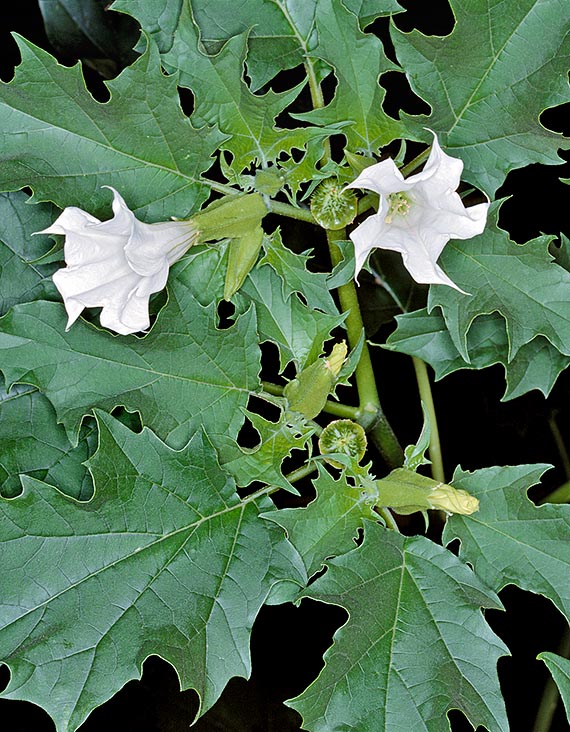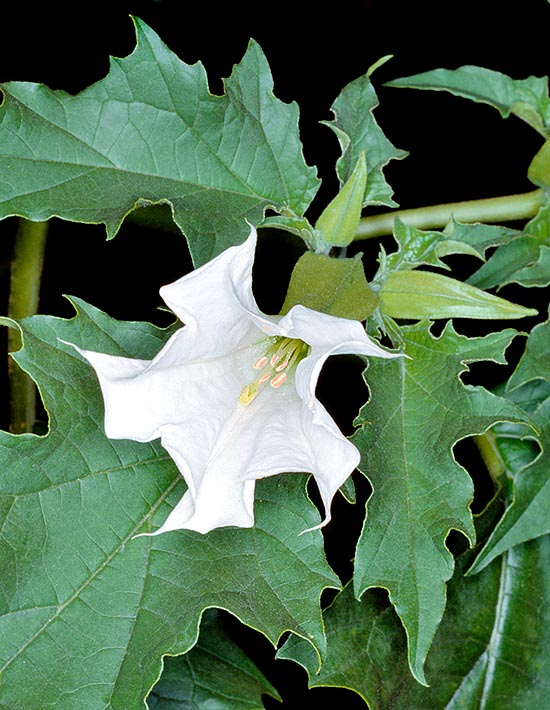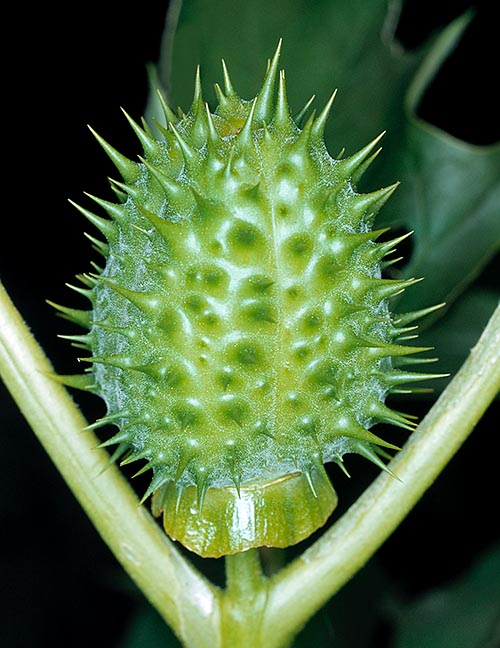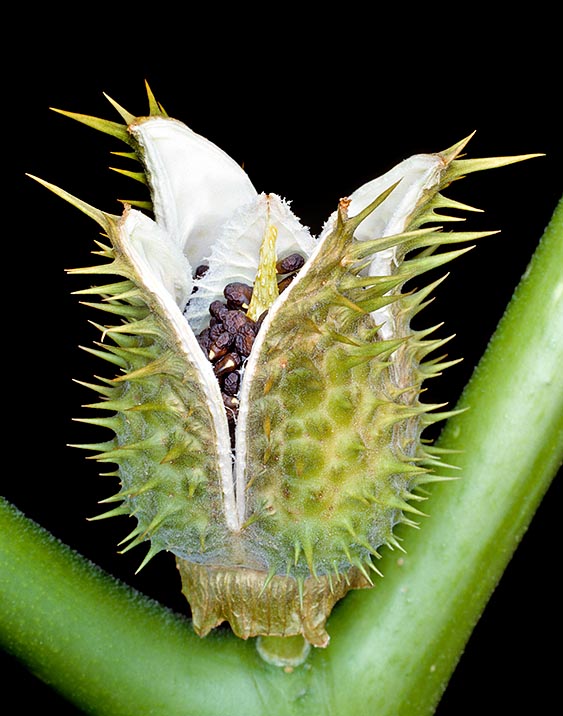Family : Solanaceae

Text © Prof. Giorgio Venturini

English translation by Mario Beltramini

Datura stramonium is common in boreal hemisphere temperate and subtropical zones © G. Mazza
The Jimson weed, or Datura (Datura stramonium Linneo, 1753), also called downy thornapple, devil’s trumpet, angel’s trumpet, thorn apple, mad apple, stink weed, is an annual herbaceous plant, with white taproot , with erect stem with bifurcations, 50-200 cm tall, belonging to the family of the Solanaceae.
The name of the genus Datura comes from the Sanskrit “dhattūrāh” ; the name of species, stramonium, comes perhaps from the Greek “στρυχνοσ” (strychnos) which is the name of a poisonous plant, probably Solanum (but means also bitter) + “μανια” (mania) = crazyness.
In Italian it is called Stramonio; in Spanish Estramonio; in German Gemeine Stechapfel; in French Stramoine, Herbe aux fous, Herbe du Diable and Trompette de la mort.
The English-American term Jimson weed (contraction of Jamestown weed) has a quite interesting origin. In 1676 in Jamestown (Virginia) broke out the first insurrection of the American settlers against the British governor. To the British soldiers despatched there to suppress the revolt, was offered a salad made from datura and soon the hallucinogenic effects did appear violently. According to a report of 1705, the soldiers, for 11 days offered “a very funny comedy because they turned mad: one blew up a feather in the air while another furiously tried to hit it with some twigs, another solder, naked, sat in a corner imitating a monkey, a fourth one kissed with passion his companions….All their acts were absolutely innocent. They were not, however, very clean as they tried to roll in their own excrements… Finally, they came to their senses, not remembering anything of what had happened.” We can understand that the military repression was not successful and therefore Jamestown was saved by the datura, which, from this fact, took the name of “plant of Jamestown”.
The Datura stramonium is a usually glabrous plant, only the young parts present a down which is lost with the growth. Leaves alternate, large (up to 20 cm), oval with strongly toothed margin, with sickening odour very noticeable if crushed. The upper face is dark green, the lower one is paler. Showy flowers, white, at times with violaceous shades, trumpet-shaped, up to 10 cm long, with elongated green calyx. The corolla has 5 petals, pleated, merged, acuminate. 5 stamina, one unique pistil with superior ovary. The stigma is bifid. The flowers are generally completely open during the night. Entomophilous pollination done by insects attracted by the penetrating and sweetish odour of the flowers. The exhalations, if inhaled for long time, cause a narcotic effect.
It produces a thorny “apple” (whence the names of mela spinosa, thornapple and Stechapfel), divided in four chambers containing numerous black bean-shaped seeds. The ripe fruit opens evidencing the four chambers and frees the seeds. The blooming happens in summer. It grows in the temperate and subtropical regions in Eurasia and in America. Very common, even a pest, in the uncultivated areas, close to ruins and at the margins of the roads.
After many scholars the origin of the genus Datura is Central-American, but the presence in the Old World in pre-Colombian period is amply documented. It is thought therefore that in some way the transportation of the plants or their seeds has happened in very old times.

Flowers open at most by night and attract insects with strong sweetish odor © Giuseppe Mazza
Toxicity and pharmacology
The whole plant is highly toxic due to the presence of the alkaloid Scopolamine or Hyoscine, Atropine (DL-Hyoscyamine), and L-Hyoscyamine, analogously to other Solanaceae such as the Henbane (Hyoscyamus niger) or the Belladonna (Atropa belladonna).
These substances act inhibiting competitively the function of the muscarinic receptors of the acetylcholine, in the central nervous system as well as in the autonomous parasympathetic nervous system (please see the text of Hyoscyamus niger). The effects of the Jimson weed on the central nervous system are more marked than that of other Solanaceae mainly cited in provoking delirium and hallucinations.
Generally, the cattle refuse to eat it, probably rejected by the bad odour and by the disgusting taste and consequently the presence of the plant in the pastures do not normally represent a danger for the animals. However, occasionally occur intoxications in the tamed animals and are reported cases in the bovines, horses, sheep, goats, pigs and poultry.
For centuries the Jimson weed has been used for treating asthma and as anaesthetic during surgeries and reductions of fractures. The anti-asthmatic utilization, due to the paralysis induced by the alkaloids of the Jimson weed on the smooth muscles of the bronchi, is very old: the use of smoking cigars or pipes of leaves of Jimson weed for the attacks of asthma is reported by the texts of Ayurvedic medicine and was imported in Europe by the end of the 18th century.
The use of the Jimson weed as anaesthetic to use during the reduction of the fractures was known by the Zuni people of New Mexico, whilst in old China it was used as anaesthetic in surgery. Presently, the Atropine and the Scopolamine contained in the Jimson weed are used in the symptomatic therapy of the Parkinson disease, in the treatment and in the prevention of the kinetosis (motion sickness) and in ophthalmology (for other uses please see the texts on Hyoscyamus niger and on Atropa Belladonna).
The Jimson weed can be used also as help in the treatments of the drug addictions, seen that it mitigates the alcoholic delirium tremens and the symptoms of morphine withdrawal. A utilization nowadays practically abandoned is that for the toothache. The toxic properties of the plant are also used for criminal purposes, especially in India. The Jimson weed is also a powerful hallucinogen used in the religious and magic rites because of the intense visions it produces. The use is however extremely dangerous due to the narrow therapeutic interval, that is of the fact that the effective doses are very close to the toxic and potentially fatal ones. There is therefore a high risk of overdose, mainly due to the ignorance of the users and to the great variability in the content of alkaloid in the plant, which may vary by a factor of 5:1 between different specimens.
The toxicity varies also with the age of the plant and is influenced by the characteristics of the soil and by the climate. It varies also, in an unpredictable manner, from leaf to leaf. Also, is much variable the ratio of the content of the various alkaloids. These erratic variations render the Datura stramonium extremely dangerous and contribute to the high frequency of serious incidents among those using it for voluptuary purpose swallowing parts of the plant or its extracts due to their psychoactive role.

The fruits is a thorny "apple" opening when ripe in 4 chambers © Giuseppe Mazza
The Jimson weed has a long history as medicine and as sacred hallucinogen. Already the old Sanskrit and Chinese texts mention the plant and Avicenna (Ibn Sinā, X century) mentions it, probably resuming a text by Dioscorides (first century). In old China they used an infusion of Datura stramonium and Cannabis in wine as anaesthetic or as hallucinogen. In India, the plant was sacred to Shiva, in the ceremonies dancing girls were offering drinks doped with its seeds and he who drunk them lost the control of his own will. The plant should have begun to grow on the chest of Śiva. Its flowers are still nowadays used in ceremonial offerings in Nepal.
The use of the Jimson weed is well reported in India and in Tibet, its effects are reported in various Ayurvedic texts. It is also cited in the Kāmasūtra (4th-6th century AD): “If the food is mixed with the fruits of the thornapple, it causes intoxications”. It is also suggested to anoint the penis with an infusion of Jimson weed before sexual intercourse in order to subdue the partner to own will.
In the Buddhist iconography the datura is linked to Buddha and to the ecstasy of the illumination. From a Mahayana Buddhist text “And then in a forest of datura trees… (Buddha) remained absorbed in contemplation …. The Buddha accepted the offerings placed in his begging bowl by the divinities living in the wood of daturas and blessed them …”
It is thought that the Jimson weed, or plants with similar pharmacological properties have been used for medical and ritualistic purposes in the old times, and some scholars have affirmed that this plant was used by the old Greeks in the Apollo Temple in Delphos (Delphic Sybil) to induce in the soothsayers the ecstasy of contact with the god.
Also in Africa, in Ethiopia, the use of the Datura stramonium for opening the mind to the divine was common.
The greatest diffusion of the magical use of the Jimson weeds is however that of the American continent, origin zone of most of the species of the genus Datura.
Thanks to the powerful hallucinations induced, in the Americas the magical and mystic use of Datura stramonium as means for the communication with the world of the spirits is extremely old. The Zuni, Pueblo people of the New Mexico, used the Jimson weed in the shamanic rites. The old inhabitants of California ingested the seeds for communicating with the gods, similarly to what was done by other American peoples, such as the Cherokee. The Jimson weed, like the other plants with similar hallucinogenic action were powerful instruments for the divination: after ingesting the substance the priest fell in trance where he was possessed by the gods or the spirits. When waking up, he revealed the content of the vivid hallucinations which then was interpreted depending on the necessities.
In Europe, the Jimson weed, along with the deadly nightshade and the henbane was one of the main ingredients of the witches ointments: the hallucinogenic substances absorbed through the skin caused flight sensations which have originated the myth of the witches flying on their broomsticks (please see the text on the henbane Hyoscyamus niger). The narcotic and hallucinogenic properties were then exploited during the Sabbaths to get the necessary demoniac visions. The magic use was so much used that at the time of witch-hunt, in England it was very much dangerous to have a Jimson weed in the orchard due to the risk of being accused of witchery. The Jimson weed was considered as a sure means for recognizing the witches: these ones, in fact, should have been irresistibly attracted by the smell of plant exposed on the sill of a window.

The tiny seeds know to wait bearing even long trips and salinity © Giuseppe Mazza
Also Kipling in the story “The King’s Ankus” in the “Jungle Book” relates about a mortal poisoning with Datura administered with a focaccia. Kipling defines it “Apple of Death is what the Jungle call thorn-apple or dhatura, the readiest poison in all India”. Finally, the Tiamat, a Swedish metal band, have produced a song about the Jimson weed. Nowadays, always more numerous are the cases of intoxications due to the voluptuary use of the Jimson weed.
In the period 1983-1987 the American National Poison Data System has referred an average of 74 voluntary intoxications per year due to anticholinergic plants like the Jimson weed, the deadly nightshade and the henbane. This value, in the period 2004-2008 has increased to an annual average of 427 (also the number of intoxications due to accidental ingestion is extremely high, during the last years stands in the order of a thousand per year).
From a Treviso newspaper, October 2013 “They have risked their lives drinking an infusion of Jimson weed, the “Devil’s trumpet”. At Pianzano di Godega Sant’Urbano, province of Treviso, three boys Alex, Luca and Mattia, 19, 20, and 23 years old, have used the hallucinogenic herb to have fun at a party. But they ended up in hospital ICU, in serious conditions. ….they were looking for a different blast for the Saturday evening”
Not rare are among the young cases of intoxications by Jimson weed associated to alcohol intoxication. The diffusion of this addiction to the voluptuary use of the Jimson weed and of other plants with similar action is also to be attributed to the media and especially to irresponsible sites present on the net. A heavy responsibility in this sense is to be also attributed to the mystical books by Carlos Castaned, such as “The Teachings of Don Juan: A Yaqui Way of Knowledge”, describing and exalting the author’s experiences, whatever true or vaunted, in the use of hallucinogenic substances like the Jimson weed, without evidencing the extreme dangerousness.
The symptoms of the intoxication in the man are the dryness of the mouth, rapid pulse, agitation, fast breathing, thirst, diarrhoea, pupil dilation. In the most serious cases appear convulsions, hallucinations, delirium, coma and, at times, death. The symptoms last usually 24-48 hours, but in some cases they have continued even for 2 weeks. For the treatment of the most serious intoxications, they use the physostigmine. This medicine inhibits the enzymatic degradation of the acetylcholine, increasing therefore its availability and so it can antagonize the alkaloids of the Jimson weed which act as competitive antagonists of the acetylcholine itself.
The social and health phenomenon of the use of hallucinogenic or narcotic vegetal substances is surely worrying but by sure not comparable to that of the “fine drug”, that is the tobacco. We must always keep in mind that they estimate that in the world every year 5 million of deaths are caused by the smoke. The gravity of this phenomenon is even bigger if we think to the problem of the passive smoking: they calculate that in Europe there are 80.000 deaths per year only for the passive smoking.
Synonyms: Datura inermis Juss; Datura tatula L.
→ To appreciate the biodiversity within the SOLANACEAE family please click here.
